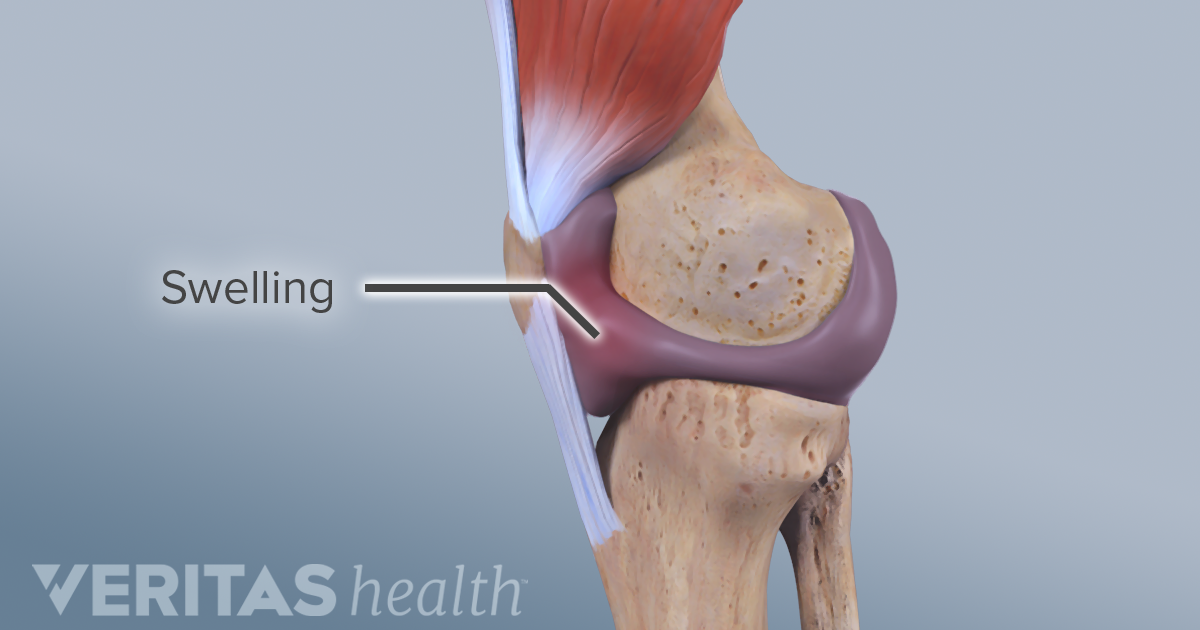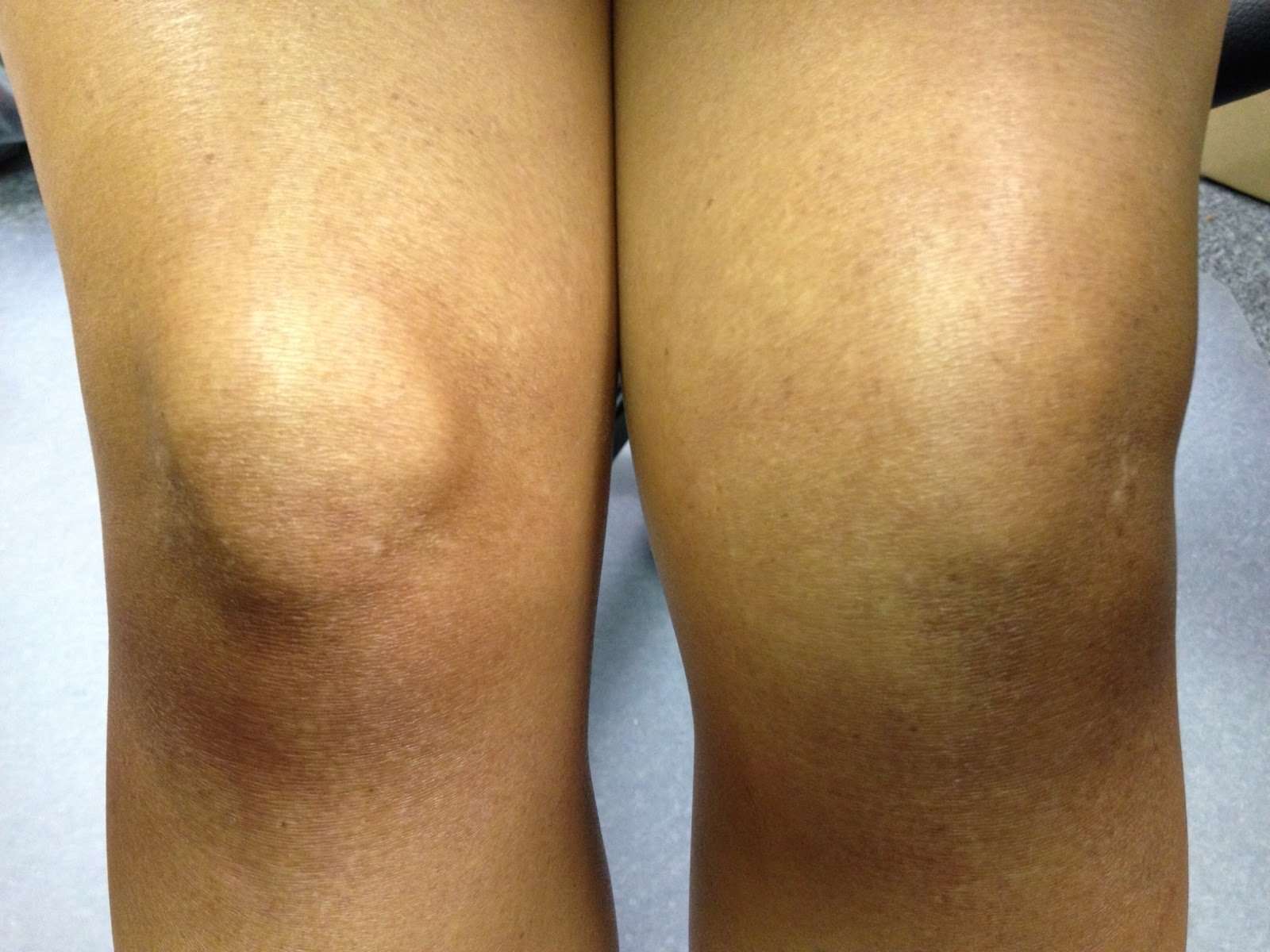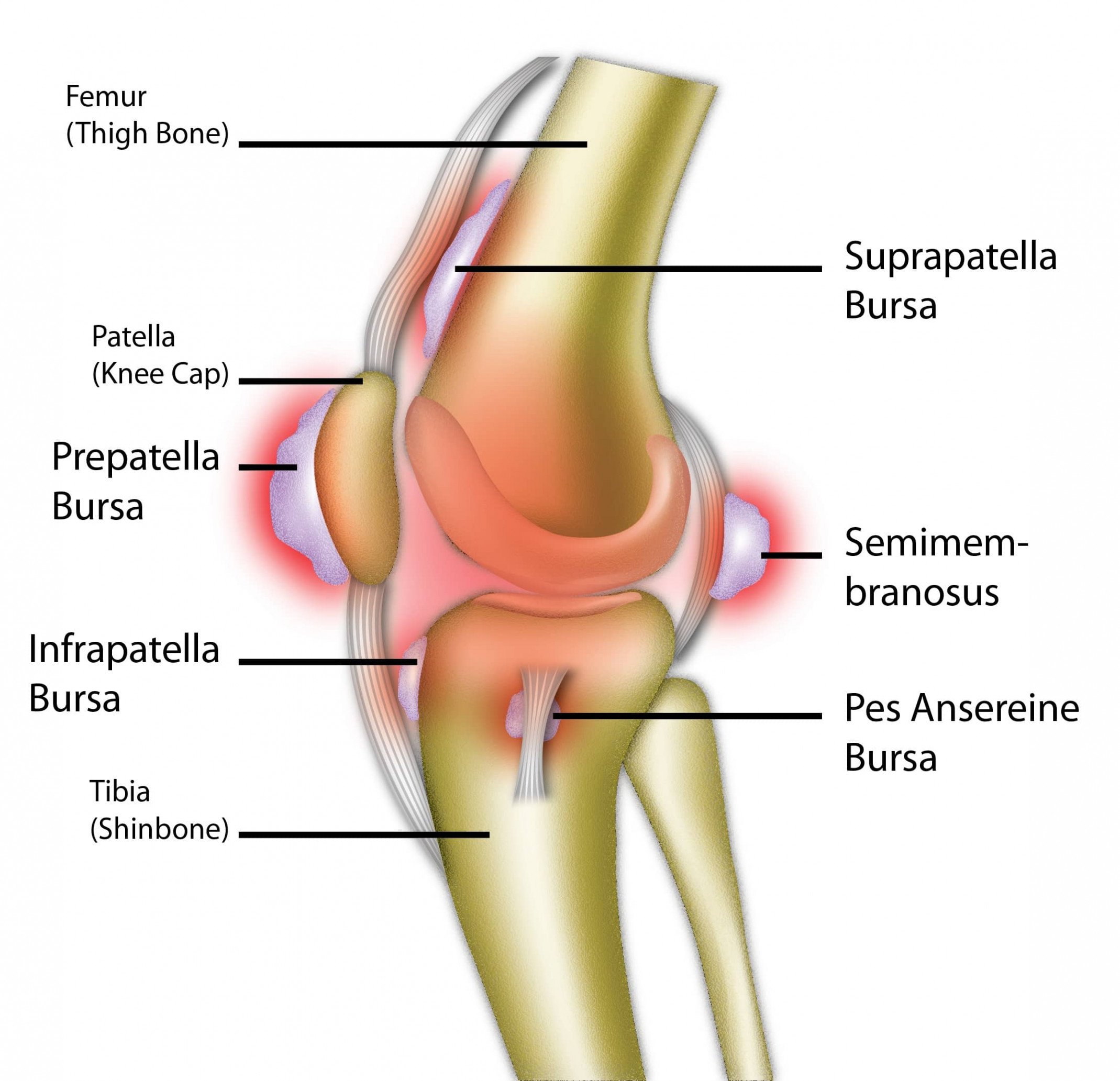How To Treat A Swollen Knee At Home
In many cases, a mild to moderately swollen knee may be treated at home. Home care typically involves Rest, Ice, Compression, and Elevation and medication. Read the descriptions of these treatments below to help maximize their benefit and avoid mistakes.
The 4-step R.I.C.E. Formula
1.Rest will give the joint time to repair and recover. Take a break from sports and other activities for 24 hours or longer. The joint should not necessarily be immobile people with knee swelling should try to gently flex and straighten the knee several times a day to maintain range of motion.
2.Icing is an easy, effective treatment for excess knee swelling. Cold therapy can ease symptoms by:
- Causing nearby blood vessels to constrict, decreasing blood flow and inflammation
- Slowing down the production of joint fluid in the knee
- Distracting the brain from pain signals to the brain
Apply a cold compress to the knee for no longer than 20 minutes at a time. This can be done several times a day.
Ice should not be applied directly to the skin. Prevent skin damage by placing a towel or another material in between the icepack and skin. Cold therapy may not be appropriate for people who have Raynauds Syndrome or nerve damage.
See When and Why to Apply Cold to an Arthritic Joint
3.Compression involves wrapping the affected joint in an elastic bandage . Compression may help limit or reduce swelling.
Keep in mind that a compression bandage will not support the knee or protect it from further injury.
Fluid Outside The Knee Joint
The most common cause of excessive fluid in the soft tissue surrounding the knee is prepatellar bursitis. This is inflammation of a fluid-filled sac which cushions the kneecap . The buildup can be seen and felt at the top of the kneecap. It is not something you would see under the knee.
An injury such as a contusion may also cause localized swelling. In some cases, the buildup of blood and fluid may mimic an acute injury of the knee joint.
Not To Be Missed If You Have Pain Behind The Knee Or Back Of The Leg
- It is very important to note that pain at the back of your knee may be referred pain from your lower back. This referred pain would most likely be a poorly localized, dull ache, not related to knee movements, but aggravated by movements in your lower back So do be aware of that possibility
- Deep Vein Thrombosis may occur following surgery, a period of immobilization such as a long flight or time spent on extended bed rest, following an injury, in woman taking estrogen, or in obese patients. It may present as pain in the calf, or in the back of the knee. There may be some mild swelling, tenderness or skin discoloration. If you are worried you may have a DVT, speak to your doctor to arrange for further investigations such as a Doppler ultrasound.
Also Check: How To Buy Knee Sleeves
Why Does My Dad Hate Me
This toxic notion is brought into parenthood, which may be the reason that you feel your father hates you. It doesnt mean he hates you he might struggle to express his love to you. Father Is Over Critical of Me. Another reason you may feel like your dad hates you is because he constantly says or does things that are critical to you.At some point, people do understand why you hate your dad when youve been living in circumstances where your rights as a child is not fulfilled by your parents. Abandonment, abusive upbringing, or forced way of living can be one of the valid reasons why you dislike your dad.Social Conditioning Why Does My Father Hates Me? Social conditioning is an essential factor that why dads are perceived as hard to deal with because most often they are. Society teaches men to have a tough exterior, especially when it comes to emotions.
The Anatomy Of The Knee Joint

The large femur sits atop the tibia, much like two pillars stacked on top of each other. The smaller fibula bone is on the outside of the tibia in the lower leg. The fibula provides some weight bearing, but not nearly as much as the tibia does. At the end of the femur are two large condyles with rounded edges that allow for the rocking or hinging motion associated with knee movement.
In between the femur and the tibia are fibrocartilage shock absorbers, or meniscus. Several large stabilizing ligaments on the inside and outside of the knee prevent excessive forward and backwards movements. These stabilizing ligaments include the Anterior Cruciate Ligament and Posterior Cruciate Ligament .
The patella bone sits in front of the femur and slides in a groove. The backside of the patella is covered with hyaline cartilage along with the front side of the groove on the femur, which minimizes the friction as the patella slides. The patella is a large sesamoid bone, which means it is surrounded in muscle or tendon. Sesamoid bones act as a pulley system to change the direction of forces, in this case from the quadriceps muscle to the tibia.
Read Also: Can Compression Socks Cause Knee Pain
When To Contact A Medical Professional
- You cannot bear weight on your knee.
- You have severe pain, even when not bearing weight.
- Your knee buckles, clicks, or locks.
- Your knee is deformed or misshapen.
- You cannot flex your knee or have trouble straightening it all the way out.
- You have a fever, redness or warmth around the knee, or a lot of swelling.
- You have pain, swelling, numbness, tingling, or bluish discoloration in the calf below the sore knee.
- You still have pain after 3 days of home treatment.
Should I Avoid Solanine
The nightshade family of vegetables includes tomatoes, potatoes, and peppers. These contain the chemical solanine. Some people believe this chemical can cause arthritis pain, but no studies or research have ever shown this claim to be true.
A person with OA needs to maintain a healthy weight, because excess weight puts additional strain on the joints. This means more pain, inflammation, and swelling.
Here are some tips to help people maintain a healthy weight.
Satiety: Natural fiber can make people feel fuller for longer, and they may help lower cholesterol or prevent diabetes. Rough oatmeal, whole grains, and fresh fruits and vegetables are all good sources of fiber.
Cooking methods: Opt for baked, grilled, steamed, and some raw foods rather than fried or roasted in oil. Deep-frying adds extra calories and takes away much of the nutritional content.
Exercise: This is important for overall fitness and maintaining a suitable weight. Knee pain may make some exercises more difficult, but simple stretching and other motion exercises can help strengthen the leg muscles, and this will make it easier to walk.
Also Check: Why Do My Knees Crack When I Bend Them
What Are Risk Factors For Knee Pain
Biomechanics: The knee joint is complicated in its operation and is used frequently throughout the day. Any change in the movement of the joint can cause subtle changes and cause pain and injuries.
Excess weight: The stress on the knee joint is increased with excess weight. Obesity also increases the risk of knee osteoarthritis as the cartilage breaks down more rapidly.
Overuse during repetitive motions as are found during certain exercises or work conditions can cause breakdown of cartilage and lead to pain.
When Should I Get My Teens Knee Pain Evaluated By A Healthcare Provider
Make an appointment to see your healthcare provider if:
- Your teens pain has lasted longer than two weeks or anytime theres an increase in pain level.
- Your teens knee is red, swollen or warm to the touch.
- Your teen cant put weight on their leg they limp.
- Your teens knee locks and cant move.
- Your teens kneecap feels like it slides out of place or the knee looks twisted.
- Your teen has knee pain during or after activity.
- Theres painful popping or clicking sound in your teens knee.
- Your teens knee doesnt have strength or full range of motion.
- Your teens pain wakes them up at night.
Last reviewed by a Cleveland Clinic medical professional on 04/30/2021.
References
Don’t Miss: Can Ice Help Knee Pain
Treatments For Swollen Knee
-
Your treatment will depend on whats causing your swollen knee and how painful it is. Your doctor will recommend the most appropriate treatment after diagnosing the underlying cause.
In most cases, youll be advised to take painkillers. You can also apply ice and elevate your knee to help reduce the swelling. Sometimes removing some of the fluid in your knee helps reduce the pain and stiffness.
Other treatments include:
Knee Pain Injuries Without Swelling Or Trauma
Most times people do not have a single incident such as a slip or fall which causes knee pain. Their pain began slowly over weeks or months. Many times there is no swelling or any single painful spot. Damage to the muscles, tendons, and ligaments that surround and stabilize the knee is the most common source of pain with trauma.
Many of us like to point to a single incident that produces or started our injuries, such as falling off a swing or a bike 10 years ago. Acute trauma can predispose people to future injuries. However, most of our soft tissue damage is the result of chronic repetitive stress injuries which are an accumulation of small amounts of trauma and stress over months and years.
Muscles and tendons not only allow movement but they also absorb pounding forces when we walk, stand, or squat. Over time, the repetitive activities cause micro damage in the soft tissues, which increases over time.
The small micro tears, or micro trauma, eventually lead to larger knee injuries. This leads to multiple spots of tenderness and tissue remodeling in the muscles, tendons, and ligaments around the knee.
Recommended Reading: How To Get Rid Of Knee Joint Pain
Symptoms That Might Indicate A Serious Condition
In some cases, behind knee swelling can signal a serious condition that should be immediately evaluated in an emergency setting. Seek immediate medical care if you, or someone you are with, have any of these serious symptoms including:
- Coldness of the feet, with weak or absent pulses
- Difficulty breathing
- High
- Loss of sensation in the lower leg
- Obvious breakage or deformity of the bones
- Paralysis
- Uncontrollable pain
Rare Causes Of A Swollen Knee

1. Knee Cap Dislocation: The patella usually glides in a groove at the front of the knee but a forceful injury can push it out to the side, resulting in a misshapened, swollen knee.
2. Patellar Tendonitis:Irritation of the patellar tendon can lead to mild swelling at the front of the knee.
3. Tumour:There are various types of tumour that can cause knee swelling. They are often accompanied by fatigue, weight loss and a general feeling of being unwell.
4. DVT: Deep vein thrombosis is a blood clot in one of the deep veins, most common in the calf or thigh. They are normally painful, hot and red and are most common after prolonged bed rest, surgery or air travel. A DVT is a medical emergency – if you suspect you may have one see your doctor immediately.
5. Spontaneous Haemarthrosis: Sudden bleeding into the joint in someone with a blood clotting problem or who is taking blood thinners e.g. warfarin.
Read Also: Can Knee Pain Cause Leg Swelling
What Else Could It Be
There are a number of other conditions that can cause pain behind the knee without typically causing much, if any, back of knee swelling visit the back of knee pain section to find out loads more.
Alternatively, it may be that there is swelling all around the knee, not just at the back, in which case, visit the swollen knee section.
When To See A Doctor
Consult a doctor if knee pain does not improve with rest or occurs with other symptoms. Also, see a doctor after a sudden injury, such as from blunt force trauma.
In addition, it is important to receive professional care if there are any indications of an infection, such as a fever or pus coming from a wound.
You May Like: What Is The Best Knee Brace For Knee Pain
What Are The Potential Complications Of Behind Knee Swelling
Swelling related to cancers may have life-threatening consequences, which depend on the type and stage of the . Left untreated, swelling due to abscesses or serious infections may lead to widespread infection in the body. Behind knee swelling and associated symptoms can be due to serious diseases, so failure to seek treatment can result in serious complications and permanent damage.
Once the underlying cause is diagnosed, it is important for you to follow the treatment plan that you and your health care professional design specifically for you to reduce the risk of potential complications including:
Joint Or Bursal Aspiration
When a patient has a swollen knee, a doctor may want to verify or rule out certain diagnoses by analyzing the accumulated fluid. To do this, the doctor will remove fluid from the affected knee joint capsule or bursa using a needle and syringe. When performed on a joint capsule, this process is called joint aspiration or arthrocentesis. When performed on a bursa, this process is called bursal aspiration.
The doctor will take note of the aspirated fluid’s color and viscosity and may send it to a lab for further analysis. Determining the contents of the fluid can lead to an accurate diagnosis. For example, uric acid crystals in the joint fluid indicate gout, and bacteria in the fluid indicate infection.
See The Joint Aspiration Procedure
Aspiration and examination of the fluid are important diagnostic steps because the underlying cause of knee swelling will determine the appropriate medical treatment.
Aspirated fluids are not always sent to a lab for analysis. If a diagnosis is already known, a physician may perform an aspiration to improve joint function and patient comfort.
See Diagnosis through Synovial Fluid Analysis
Recommended Reading: How To Get Rid Of Arthritis Pain In Your Knee
What Causes Knee Pain
Knee pain can have many different causes. Common causes of knee pain include:
- Overuse injury
You May Have An Autoimmune Condition
In addition to rheumatoid arthritis, a number of other autoimmune conditionsin which the immune system attacks the body in various wayscan contribute to swelling and pain throughout the body, including in the knees.
Though less common, systemic autoimmune conditions, like lupus, may cause swelling, Dr. Gladstone says. Like Lyme, these conditions may explain inflammation in the knees when nothing else can. Along with pain and swelling, people with autoimmune conditions often experience chronic fatigue, muscle aches, and low fevers.
Stay updated on the latest science-backed health, fitness, and nutrition news by signing up for the Prevention.com newsletter here.
Read Also: When Will My Knee Replacement Feel Normal
What Can Cause Knee Pain Without Injury
Most people assume that their knee pain isnt severe or in need of medical attention because they havent suffered a significant injury. While that may be true sometimes, damage to your knee joint can also occur slowly over time, and affect you just as much as a significant accident or injury can.
First, lets stop with assumptions. Any pain you are experiencing is a sign that something is not right. So, why not have a specialist take a look? With extensive imaging, a trained orthopedic specialist can get to the bottom of your nagging knee pain and try to help relieve some of that distress. If you havent suffered an injury, however, your doctor will want to diagnose the pain and possible causes. There are some more common causes for non-trauma related knee pain:
Arthritis
Either rheumatoid arthritis or osteoarthritis can cause leave you with severe knee pain, even without a fall or injury. Osteoarthritis can be characterized by the pain and swelling you continue to feel as you age. Your joints are not indestructible, and the structure inevitably wears down over time. Rheumatoid arthritis, on the other hand, is a chronic disorder that also causes joints to swell. If you suspect RA is behind your knee pain, you might have pain in other joints, as well.
A tear
Bursitis
Tendonitis
Or Something Known As Pseudogout

Also known as “false gout” or calcium pyrophosphate dihydrate deposition disease , psuedogout can also cause swelling of the knee joint. Like gout, pseudogout is also considered a form of arthritis. Unlike gout, it primarily affects the wrists and knees. In pseudogout, a form of calcium crystals accumulate in joint cartilage and fluid, causing the same sudden joint pain and swelling as gout.
Pseudogout typically affects people over the age of 60, according to The Cleveland Clinic. People who have osteoarthritis, thyroid or metabolic issues, or kidney disease are also more likely to experience it.
Also Check: How Long Does It Take To Recover Knee Replacement